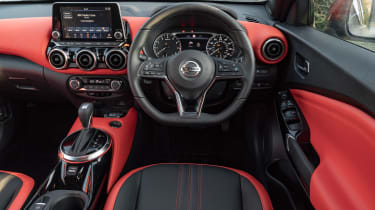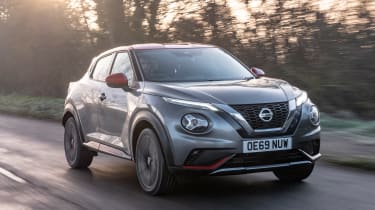Nissan Juke SUV: old vs new
The first Nissan Juke kicked off the small SUV class; how does the new one compare?
If you’re keen on a small SUV, you’ve got the Nissan Juke to thank, as it’s widely credited as the car that established the ‘supermini-based crossover’ class. The styling didn’t please everyone but it was an undoubted sales success, with around 100,000 sold in Europe for seven consecutive years. By the time it was replaced in 2019, the competition had caught up and the Juke was feeling outdated compared to its many rivals, including the Renault Captur, SEAT Arona, Ford Puma and Honda HR-V.
Best small SUVs to buy this year
Unsurprisingly, Nissan hasn’t drastically changed the recipe for the new Juke, but there are improvements across the board. Practicality is improved, and it should also be more economical to run and offer improved performance over the old model.
Nissan Juke Styling
The original Nissan Juke looked like nothing else on the road when it was launched in 2010. It came with an interesting split headlight design (the indicators were mounted on top of the front wings and the headlights sat under the grille) and at the back, the boomerang-shaped tail-lights and wide wheel arches made the car look squat. A facelift in 2014 brought redesigned light clusters and a reshaped rear bumper.
The styling of the current model is clearly influenced by its predecessor but with a more confident face achieved by slim LED daytime running lights, a bigger grille and sharper metal creases. The new grille brings the Juke in line with the bigger Nissan Qashqai, while the rear end gets sharp new brake lights like those on the Nissan Micra. A higher roofline improves rear-seat space. Nissan’s multi-level headlight arrangement has since come into fashion, with cars like the Citroen C3 Aircross, Hyundai Kona and Skoda Kamiq all featuring similar design cues.
Interior
Nissan gave the first Juke an interior that was as funky as the exterior styling, and it doesn’t look quite as dated as a supermini or family hatchback of the same age. The rate of technological progress in recent years is shown by the infotainment screen, though. It’s tiny by modern standards - not helped by lots of shortcut buttons and a CD player - and the graphics aren’t very clear. We also found lots of scratchy, cheap-feeling materials that don’t give you confidence about the quality of the interior.
The new Juke is much more conventional inside. Now measuring eight inches, the touchscreen is easier to use - although you still don’t get it on the cheapest Visia trim level. Material quality has improved, with leather and a suede-like fabric used on some specifications, and we like the colourful fascia accents too. All cars get bright LED headlights, Bluetooth and cruise control (the last car’s entry model got none of these), and top-spec cars aren’t left wanting for kit.
Practicality
We call them ‘small SUVs’ but the emphasis was definitely on the word ‘small’ for the first Nissan Juke. Its coupe-like shape and wide wheel arches meant passenger space was pretty meagre, and those in the rear seats could feel claustrophobic quite quickly. You won’t find many storage cubbies for your odds and ends, and pre-2014 cars have a really small boot at 251 litres - the same as a Skoda Citigo city car. If boot space is of any importance, a post-facelift model is much better, with a much more competitive (but still far from class-leading) 354 litres.
Both longer and wider, the latest Nissan Juke is thankfully much better at transporting a group of people and their luggage. Headroom and legroom have been improved in the back, and rear-seat passengers now have more space than they would in a Hyundai Kona, for example. It’s still not the most practical or flexible crossover but you could conceivably have one as a family car - especially as the boot is also much more usable. Now measuring 422 litres (bigger than family hatchbacks like the Volkswagen Golf), the boot is also easier to access thanks to a wider opening.
Performance and fuel economy
Owning an original Nissan Juke meant you were prioritising funky styling over the driving experience because neither fuel economy nor performance was a strong point. A 1.6-litre petrol engine was offered in two forms - turbocharged and naturally aspirated - alongside a 1.5-litre diesel. Not even the (admittedly ageing) diesel managed 50mpg on the WLTP emissions test, which was quite poor considering many small petrols can now hit that figure. The naturally aspirated petrol, incidentally, returns 35mpg. Accelerating from 0-62mph takes 11.2 seconds in diesel models and 12.5 seconds in the 1.6-litre petrol.
A 1.2-litre turbo petrol was also offered for a short time, and this engine is easier to recommend because it makes the car both more economical and faster than the engines mentioned above. If you’re set on a Juke and want more performance, you’ll want to hunt out the Nismo-tuned Juke, with either 197 or 215bhp; the latter hits 0-62mph in seven seconds.
The new Juke is only available with a 1.0-litre turbo petrol at the moment but it’s considerably more modern than the engines available in the previous model. It manages 47.9mpg and a 10.4-second 0-62mph time, and is much sharper to drive thanks to its shared underpinnings with the Renault Clio. A hybrid version is also thought to be on the horizon.
Safety
The original Juke scored five stars in its 2011 Euro NCAP safety test, and the 2014 facelift brought more safety kit. Nissan’s ‘Safety Shield’ pack was standard on Tekna models and includes lane-departure warning, blind-spot monitoring and tyre-pressure monitoring. The safety test gets more stringent every year, so it’s good to see the new Juke also gained a maximum star rating. Auto emergency braking and lane-keeping assist are now standard, while the extra safety pack is now available optionally on lower trim levels. You can even order Nissan’s ProPilot pack, which effectively allows the car to drive itself in one motorway lane.
Verdict
The new Nissan Juke doesn’t represent anything as new or different as the original model, but it’s a much better car and isn’t so compromised compared with its rivals. With improved practicality, a better-equipped interior and a more modern engine, the new Juke is vastly superior to its predecessor. If you can afford it, the new model is definitely worth choosing over the old one.
The Juke will soon be joined in the Nissan range by the electric Nissan Ariya SUV. Read about it here.
Recommended

New Subaru Trailseeker revealed as rugged electric SUV with 375bhp

New Subaru Solterra brings more range, power and polish
Most Popular

New Smart #5 Brabus is a 637bhp far cry from the brand’s city car past

Best car leasing deals 2025: this week’s top PCH offers
Tips & advice

Car dashboard warning lights: what does each symbol mean?

Electric car charging stations: public networks, charger types, apps and maps















